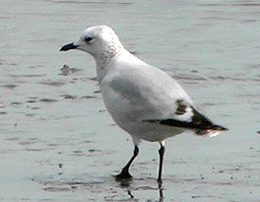The highly charismatic Relict Gull Larus relictus has a small, declining population, breeding very locally on steppe lakes in Mongolia and adjacent parts of Kazakhstan, Russia, and China. Once thought to be an eastern form of Mediterranean Gull Larus melanocephalus, Relict Gulls are highly susceptible to disturbance and predation on the breeding colonies, and threatened by wetland developments in their non-breeding range: the population is put at between 2,500 and 10,000 and is listed as Vulnerable in the BirdLife International Red Data Book.

The non-breeding range is very poorly understood, though recent survey work in South Korea and a series of high counts from China suggests very clearly that the majority of these splendid gulls must be wintering in northern parts of the Yellow Sea, coming south only in exceptionally hard winters: the largest flock in Korea, for example, was one of 143, recorded in 2001 during one of the coldest winters in 50 years.
Records in Korea are mainly concentrated around the major estuary systems in the west and the south, and like the Saunders's Gull the Relict Gull is a tidal-flat specialist, but unlike Saunders's it prefers sandy or mud-sand mix substrates and is thus usually found at the outer part of estuaries or even occasionally on sandy beaches.
The data reproduced below is from survey and banding work conducted by Dr He Fen-qi, who has been working with the largest breeding colony of the Relict Gull in Inner Mongolia since the beginning of the 1990s.
The colony is sited at the so-called T-A Nur, and its importance has been recognised by it being named this year as a new Chinese Ramsar site (No. 1146?).
Dr He has kindly shared the results of his work with us, in the hope that banded birds will be seen in the Korean peninsula, and records passed on to him. It is also to be hoped that if enough data can be built up on the occurrence of the Relict Gull in Korea, then perhaps vital sites here can be recognised as being worthy of Ramsar designation also?
"We started banding chicks of the gull in 1998. Some chicks are banded with both a metal ring on the right leg and a bright yellow colour ring on the left leg: legflags have not been used.
Details of our banding work are as follows:
In 1998, about 580 birds banded, with both metal and plastic colour rings;
In 1999, about 150 birds banded, 101 with both metal and plastic colour rings and the others with colour ring only;
In 2000, about 2,280 birds banded, nearly 1,000 of them with both metal and colour rings while the others with metal ring only;
In 2001, about 2,200 birds banded, nearly 1,000 of them with both metal and colour rings while the others with metal ring only;
This year (2002), we did not band any chicks due to the unusual drought which caused an extremely low hatching rate.
So far as we know, some 20-30 birds have been seen at several localities along the Bo Hai (Sea) coast successively in 1998, 2000, and 2001 by birders.
He Fen-qi, Sept 2002.



